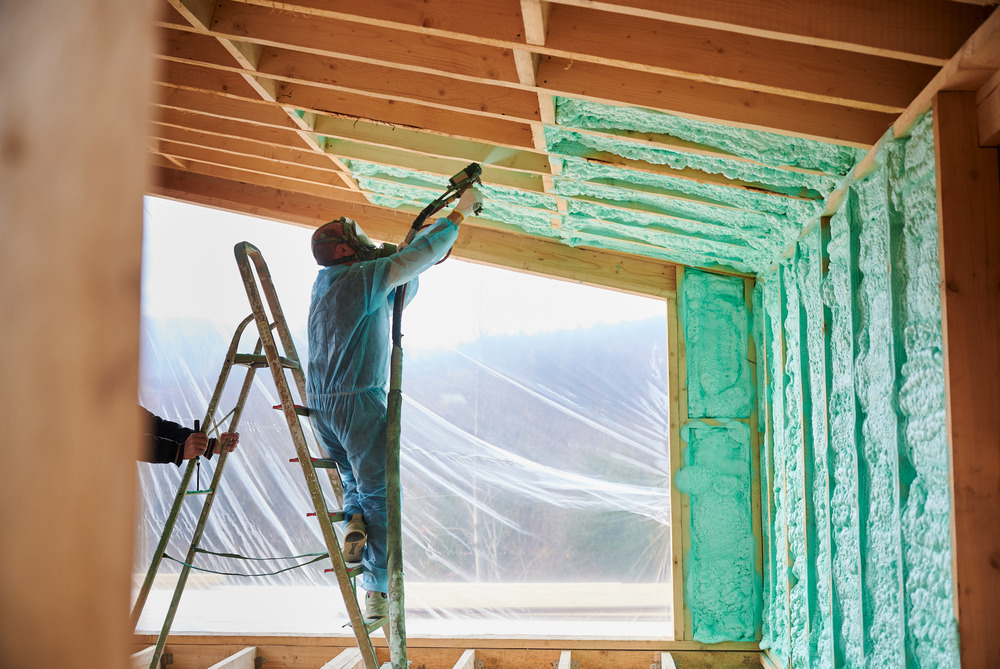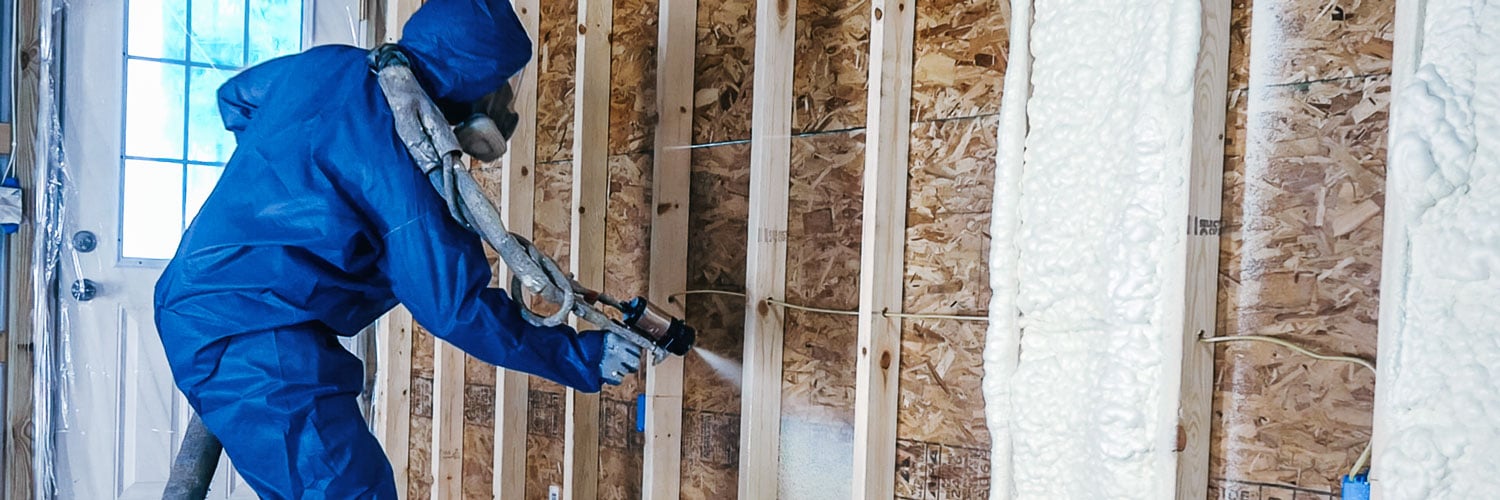Comparing Spray Foam to Standard Insulation: Which Is Better?
Comparing Spray Foam to Standard Insulation: Which Is Better?
Blog Article
Spray Foam: The Ultimate Service for Air Sealing and Insulation
Spray foam insulation has actually become a leading service for efficient air securing and thermal insulation, offering a distinct combination of buildings that set it aside from standard approaches. Its ability to expand and fill up spaces makes it specifically reliable in preventing air leakage, which can considerably affect power performance. Nonetheless, recognizing the full scope of its benefits, installation processes, and comparisons with other insulation types is essential for making notified decisions. As we discover these facets, the effects for both brand-new buildings and retrofits end up being progressively considerable. What elements should influence your choice?
What Is Spray Foam?
Spray foam is a versatile insulation product that integrates the principles of air securing and thermal resistance to boost energy effectiveness in structures. Made up mainly of polyurethane or various other comparable compounds, spray foam is used as a liquid that expands upon call with surfaces, developing a solid, continuous layer of insulation. This special residential property enables it to fill spaces, cracks, and gaps that conventional insulation products may overlook, supplying an exceptional air seal.
There are 2 main kinds of spray foam: open-cell and closed-cell. Open-cell spray foam is lighter and much more adaptable, providing excellent noise absorption and a reduced R-value per inch - Spray Foam. In contrast, closed-cell spray foam is denser, giving a higher R-value, dampness resistance, and added structural honesty to developing parts
The application process normally involves specific tools, guaranteeing a smooth application that follows different substratums, including concrete, wood, and steel. This versatility makes spray foam ideal for both brand-new constructions and retrofitting existing frameworks. Its capacity to create an airtight obstacle dramatically adds to decreasing power intake and boosting indoor air high quality, consequently making it a recommended choice among home builders and home owners alike.
Benefits of Spray Foam Insulation
Among one of the most substantial benefits of spray foam insulation is its exceptional ability to produce a continual air obstacle, which successfully reduces power loss. Unlike typical insulation materials, spray foam broadens to fill up spaces and cracks, making certain that air leakage is considerably decreased. This characteristic not only enhances energy efficiency yet additionally brings about decrease energy expenses gradually.
Additionally, spray foam insulation supplies exceptional thermal resistance, adding to a more stable interior setting. Its high R-value per inch enables efficient insulation in confined spaces, making it ideal for attic rooms, wall surfaces, and crawl areas. The moisture-resistant properties of spray foam aid avoid mold and mold growth, advertising healthier living conditions.
An additional vital benefit of spray foam insulation is its sound-dampening top qualities (Spray Foam). It efficiently lowers sound transmission between spaces, creating a quieter and extra comfortable home setting. The toughness of spray foam also attracts attention, as it does not sag or resolve gradually, maintaining its performance throughout its life-span
Exactly How Spray Foam Functions
Understanding just how spray foam insulation works is necessary for appreciating its efficiency in air sealing and thermal resistance. Spray foam insulation consists of 2 primary parts: isocyanate and polyol resin. When these elements are combined, they undergo a chemical response that creates the material to broaden swiftly, creating a thick foam that loads cavities, fractures, and voids.
As the foam increases, it abides by surfaces, developing an impermeable seal that significantly minimizes air seepage. This characteristic makes spray foam insulation highly efficient at protecting against drafts and moisture penetration, which can result in energy loss and damages gradually. In addition, the closed-cell version of spray foam offers superior thermal resistance due to its stiff structure, successfully lessening warmth transfer.
The one-of-a-kind properties of spray foam allow it to adapt irregular surfaces, ensuring comprehensive coverage and a seamless obstacle. As an outcome, spray foam insulation not just boosts power performance yet additionally adds to boosted interior air high quality by decreasing the accumulation of allergens and toxins. Eventually, understanding the mechanics behind spray foam emphasizes its duty as a remarkable option for insulation and air sealing in both industrial and domestic applications.
Setup Process Review

Prior to installation, the area has to be properly cleaned up and prepped, ensuring that surfaces are without debris, wetness, and dirt. This action is critical because contaminants can jeopardize bond and general efficiency. When the location is prepared, the application includes blending both parts of the spray foam, which increases upon call read this article and loads voids properly.
Educated experts must carry out the installment, using customized tools to make certain consistent insurance coverage and optimum thickness. Security safety measures, including using protective gear and ensuring correct air flow, are imperative throughout this procedure. After application, the foam normally remedies rapidly, click here for more forming a solid obstacle that boosts power effectiveness.
Comparing Spray Foam to Traditional Insulation
When reviewing insulation choices, spray foam insulation stands out in comparison to standard materials such as fiberglass and cellulose. Unlike fiberglass and cellulose, which can permit air infiltration, spray foam broadens upon application, filling holes and gaps to produce an airtight seal.
Furthermore, spray foam provides a greater R-value per inch than traditional insulation types, supplying more reliable thermal resistance in a thinner profile. This particular is specifically useful precede with restricted dental caries depth. Moreover, spray foam is immune to moisture and mold and mildew development, which can be a considerable worry about cellulose and fiberglass, particularly in damp settings.
Nonetheless, spray foam insulation generally brings a greater ahead of time cost than its standard equivalents. Property owners need to consider this initial investment versus lasting energy cost savings and efficiency advantages. Ultimately, while both insulation types serve their function, spray foam becomes an advanced service for contemporary insulation demands, specifically in regards to air securing and thermal efficiency.

Conclusion
In summary, spray foam insulation represents a highly effective remedy for achieving optimal air securing and thermal resistance. Its one-of-a-kind properties, consisting of dampness resistance and noise dampening, make it appropriate for various applications in both new building and constructions and retrofitting tasks (Spray Foam). The first costs might be greater compared to typical insulation materials, the long-term advantages, such as considerable energy cost savings and enhanced indoor air top quality, validate the investment and highlight its value in modern-day building techniques.
Spray foam insulation has arised as a leading service for reliable air sealing and thermal insulation, offering a special combination of buildings that set it apart from traditional techniques.Spray foam is a versatile insulation product that incorporates original site the principles of air securing and thermal resistance to enhance power efficiency in buildings.When reviewing insulation choices, spray foam insulation stands out in contrast to traditional products such as fiberglass and cellulose. Inevitably, while both insulation types serve their objective, spray foam arises as a much more innovative solution for contemporary insulation demands, particularly in terms of air securing and thermal performance.
In summary, spray foam insulation represents an extremely reliable service for accomplishing optimum air sealing and thermal resistance.
Report this page